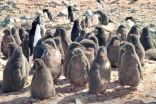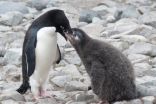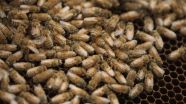(Press-News.org) Adélie penguins are an indigenous species of the West Antarctic Peninsula (WAP), one of the most rapidly warming areas on Earth. Since 1950, the average annual temperature in the Antarctic Peninsula has increased 2 degrees Celsius on average, and 6 degrees Celsius during winter.
As the WAP climate warms, it is changing from a dry, polar system to a warmer, sub-polar system with more rain.
University of Delaware oceanographers recently reported a connection between local weather conditions and the weight of Adélie penguin chicks in an article in Marine Ecology Progress Series, a top marine ecology journal.
Penguin chick weight at the time of fledgling, when they leave the nest, is considered an important indicator of food availability, parental care and environmental conditions at a penguin colony. A higher chick mass provides the chick a better likelihood of surviving and propagating future generations.
In the study, Megan Cimino, a UD doctoral student in the College of Earth, Ocean, and Environment and the paper's lead author, compared data from 1987 to 2011 related to the penguin's diet, the weather and the large-scale climate indices to see if they could correlate year-to-year penguin chick weight with a particular factor. She also evaluated samples from the penguin's diet to determine what they were eating.
"The ability of a penguin species to progress is dependent on the adults' investment in their chicks," said Matthew Oliver, an associate professor of marine science and policy and principal investigator on the project. "Penguins do a remarkable job of finding food for their chicks in the ocean's dynamic environment, so we thought that the type and size distribution of food sources would impact chick weight."
Impact of weather and climate
Instead, the study revealed that weather and overall atmospheric climate seemed to affect weights the most. In particular, local weather — including high winds, cold temperatures and precipitation, such as rain or humidity — had the largest impact on penguin chick weight variations over time. For example, westerly wind and air temperature can cause a 7-ounce change in average chick weights, as compared to 3.5-ounce change caused by wind speed and precipitation. A 7-ounce decrease in chick weight could be the difference between a surviving and non-surviving chick.
Cimino explained that while penguins do build nests, they have no way of building nests that protect the chicks from the elements. This leaves penguin chicks unprotected and exposed while adult penguins are away from the nest. Precipitation, while not considered a key variable, can cause chick plumage to become damp or wet and is generally a major factor in egg and chick mortality and slow growth.
"It's likely that weather variations are increasing the chicks' thermoregulatory costs; and when they are cold and wet, they have to expend more energy to keep warm," she said.
The wind can also affect the marine environment, she continued, mixing up the water column and dispersing the krill, a penguin's main source of food, which may cause parent penguins to remain at sea for longer periods of time and cause chicks to be fed less frequently.
"This is an interesting study, because it calls into question what happens to an ecosystem when you change climate quickly: Is it just large-scale averages that change the ecosystem or do particular daily interactions also contribute to the change," Oliver said.
Research team
Other co-authors on the paper include William Fraser and Donna Patterson-Fraser, from the Polar Oceans Research Group, and Vincent Saba, from NOAA National Marine Fisheries Service. Fraser and Patterson have been collecting data on Adélie penguins since the late 1970s, creating a strong fundamental data set that includes statistics collected over decades, even before rapid warming was observed.
By correlating the relevant environmental variables through analysis of data from sources such as space, weather stations, etc., the researchers were able to scientifically validate a potential cause for chick weight variation over time. Using big data analyses to statistically sift through the possible causes allowed the researchers to take a forensic approach to understanding the problem.
"Climate change strikes at the weak point in the cycle or life history for each different species," Oliver said. "The Adélie penguin is incredibly adaptive to the marine environment, but climate ends up wreaking havoc on the terrestrial element of the species' history, an important lesson for thinking about how we, even other species, are connected to the environment."
Cimino will return to Antarctica next month to begin working with physical oceanographers from University of Alaska and Rutgers, through funding from the National Science Foundation. Using robotics, she will investigate what parent penguins actually do in the ocean in order to gain a broader perspective on how the penguins use the marine environment. In particular, she hopes to explore other possible contributing factors to chick weight variation such as parental foraging components that were not part of this study.
"It's important for us to understand what's going on, especially as conditions are getting warmer and wetter, because it may give us an idea of what may happen to these penguins in the future," Cimino said.
INFORMATION:
The work reported here is supported in part through funds from the National Marine Fisheries Service, NASA and the National Science Foundation.
University of Delaware study connects penguin chick weights to local weather conditions
2014-10-27
ELSE PRESS RELEASES FROM THIS DATE:
Cost of informal caregiving for US elderly is $522 billion annually, study finds
2014-10-27
The price tag for informal caregiving of elderly people by friends and relatives in the United States comes to $522 billion a year, according to a new RAND Corporation study.
Replacing that care with unskilled paid care at minimum wage would cost $221 billion, while replacing it with skilled nursing care would cost $642 billion annually.
The study, published online by the journal Health Services Research, improves on earlier estimates about the value of informal caregiving by making use of the 2011 and 2012 American Time Use Survey, a new and unique database, to provide ...
PET scans reveal how psychodynamic therapy for depression may change brain function
2014-10-27
A study from Massachusetts General Hospital (MGH) investigators has identified for the first time changes in the metabolic activity of a key brain region in patients successfully treated for depression with psychodynamic psychotherapy, suggesting a mechanism of action behind one of the most historically important and widely practiced forms of therapy. They also found evidence that pretreatment metabolism in a different brain structure might predict which patients are likely to respond to that form of therapy. Their report will appear in the journal Psychotherapy and Psychosomatics ...
Blood vessel growth in the brain relies on a protein found in tumor blood vessels
2014-10-27
Do blood vessels that feed tumors differ from other blood vessels? Fourteen years ago, experiments designed to answer that question led to the discovery of several genes that are more active in tumor-associated blood vessels than in normal blood vessels. New research now reveals the normal function of one of those genes and suggests it could be a good target for anticancer drug therapy.
A summary of the research appears in the journal Developmental Cell on Oct. 27.
The mystery of the gene, TEM5, began in 2000 with research conducted by Brad St. Croix, Ph.D., working ...
Using microscopic bugs to save the bees
2014-10-27
For decades, honeybees have been battling a deadly disease that kills off their babies (larvae) and leads to hive collapse. It's called American Foulbrood and its effects are so devastating and infectious, it often requires infected hives to be burned to the ground.
Treating Foulbrood is complicated because the disease can evolve to resist antibiotics and other chemical treatments. Losing entire hives not only disrupts the honey industry, but reduces the number of bees for pollinating plants.
Now researchers at BYU have produced a natural way to eliminate the scourge, ...
Group classes teach parents effective autism therapy, Stanford/Packard study finds
2014-10-27
Parents can learn to use a scientifically validated autism therapy with their own children by taking a short series of group classes, a new study by researchers at the Stanford University School of Medicine and Lucile Packard Children's Hospital Stanford has found.
The therapy helped children improve their language skills, an area of deficiency in autism, according to the study, which will be published Oct. 27 in the Journal of Child Psychology and Psychiatry. The study is the first randomized, controlled trial to test whether group classes are a good way to train parents ...
A GPS from the chemistry set
2014-10-27
You don't always need GPS, a map or a compass to find the right way. What demands a tremendous amount of computational power from today's navigation computers can also be achieved by taking advantage of the laws of physical chemistry and practicing so-called "chemical computing". The trick works as follows: A gel mixed with acid is applied at the exit of a labyrinth – i.e. the destination – filled with alkaline liquid. Within a shorttime, the acid spreads through the alkaline maze, although the majority of it remains together with the gel at the exit. When an ...
The chemistry of death (video)
2014-10-27
WASHINGTON, Oct. 27, 2014 — It's a spooky question, but it doesn't have to be: What happens when you die? Even after you depart, there's a lot of chemistry that still goes on inside you. Reactions teamed up with mortician Caitlin Doughty, author of the new book "Smoke Gets in your Eyes, and Other Lessons from the Crematory" to demystify death and talk about exactly what happens to the body postmortem. Check out the new episode here: http://youtu.be/BpuTLnSr_20.
Subscribe to the series at Reactions YouTube, and follow us on Twitter @ACSreactions to be the first to ...
Taxi GPS data helps researchers study Hurricane Sandy's effect on NYC traffic
2014-10-27
When Hurricane Sandy struck the east coast in late October 2012, the "superstorm" disrupted traffic in New York City for more than five days, but the evacuation proceeded relatively efficiently with only minor delays, according to transportation researchers at the University of Illinois. The largest Atlantic hurricane on record, Hurricane Sandy offered a chance for researchers at the University of Illinois at Urbana-Champaign to try out a new computational method they developed that promises to help municipalities quantify the resilience of their transportation systems ...
Leading medical groups urge Congress to stop steep Medicaid cuts
2014-10-27
WASHINGTON, DC—The American Academy of Pediatrics (AAP), American Academy of Family Physicians (AAFP), American College of Physicians (ACP) and American Osteopathic Association (AOA) convene today in Washington, DC to urge Congress to extend current-law payment parity for primary care and immunization services under Medicaid for at least two years. Absent congressional action, federal support for this policy runs out at the end of the year. Collectively representing nearly 423,000 physicians, the four groups are meeting with dozens of congressional offices on Capitol ...
Which US airports are breastfeeding friendly?
2014-10-27
New Rochelle, NY, October 27, 2014—More than half of women with children less than a year old are working, and work travel can make breastfeeding a challenge. A study of 100 U.S. airports found that few provided a suitably equipped, private lactation room, even though most described themselves as being breastfeeding friendly, as reported in Breastfeeding Medicine, the official journal of the Academy of Breastfeeding Medicine published by Mary Ann Liebert, Inc., publishers. The article is available free on the Breastfeeding Medicine website at http://online.liebertpub.com/doi/full/10.1089/bfm.2014.0112 ...





